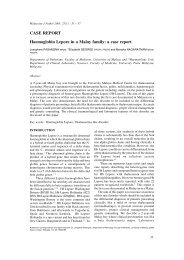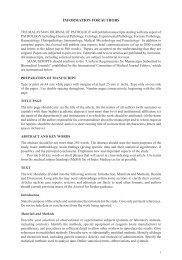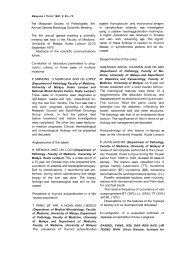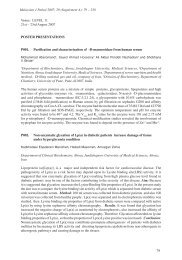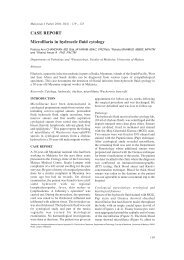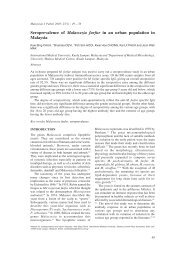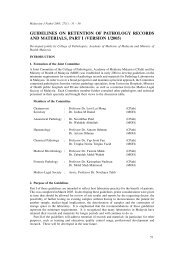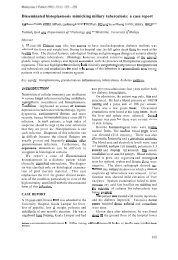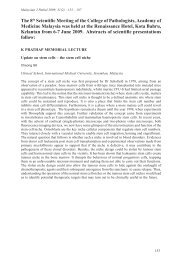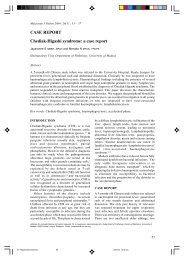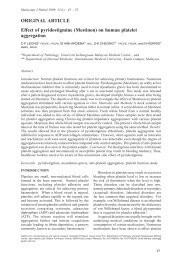CASE REPORT Unilateral gestational macromastia- a rare ... - MJPath
CASE REPORT Unilateral gestational macromastia- a rare ... - MJPath
CASE REPORT Unilateral gestational macromastia- a rare ... - MJPath
Create successful ePaper yourself
Turn your PDF publications into a flip-book with our unique Google optimized e-Paper software.
Malaysian J Pathol 2004; 26(2) : 125 – 128<br />
GESTATIONAL MACROMASTIA<br />
<strong>CASE</strong> <strong>REPORT</strong><br />
<strong>Unilateral</strong> <strong>gestational</strong> <strong>macromastia</strong>- a <strong>rare</strong> disorder<br />
K Sharma MD, S Nigam MD, Nita Khurana MD and K Uma Chaturvedi MD<br />
Department of Pathology, Maulana Azad Medical College, Lok Nayak Hospital, Delhi-02, India.<br />
Abstract<br />
Macromastia is the massive enlargement of the breast, unilateral or bilateral, disproportionate to the<br />
growth of the rest of the body. It is called gravid <strong>macromastia</strong> or gigantomastia of pregnancy when<br />
it occurs during pregnancy. It may or may not regress following parturition. Gestational <strong>macromastia</strong><br />
is exceptionally <strong>rare</strong>. We report a 28-year-old female with gigantomastia of the left breast. She<br />
presented at four months post-partum with painful massive enlargement of the left breast since the<br />
third month of pregnancy. The overlying skin was stretched out and showed multiple ulcers with foul<br />
smelling discharge. The nipple and areola were unremarkable. Simple mastectomy was done, as fine<br />
needle aspiration cytology was suggestive of phylloides tumour. The breast specimen measured 30<br />
x 30 x 9 cm and was replaced totally by grey-white tissue involving all the resection margins. No<br />
normal breast tissue or fat was identified. Histopathology showed periductal as well as diffuse<br />
fibrosis, adenosis and lactational changes. No features of phylloides tumour or carcinoma were<br />
present and it was diagnosed as unilateral <strong>gestational</strong> <strong>macromastia</strong>.<br />
Key words: Macromastia, Gigantomastia, Gestational.<br />
INTRODUCTION<br />
Macromastia is the massive enlargement of one<br />
or both breasts, disproportionate to the growth of<br />
the rest of the body. The breast rapidly grows to<br />
a large size and spontaneous remission is <strong>rare</strong>ly<br />
seen. 1 It has also been defined as enlargement of<br />
the breast with a weight exceeding 600 grams<br />
and causing discomfort. 2 To differentiate<br />
<strong>macromastia</strong> from moderate to minimal breast<br />
enlargement, additional criteria include stretching<br />
of the overlying skin causing ulceration. 3 Gravid<br />
<strong>macromastia</strong>, also called gigantomastia of<br />
pregnancy, is extremely <strong>rare</strong> and refers to massive<br />
enlargement of the breast in pregnancy. It may or<br />
may not regress following parturition. 4 We report<br />
a 28-year-old female who had gigantomastia of<br />
the left breast.<br />
<strong>CASE</strong> <strong>REPORT</strong><br />
A 28-year-old post-partum female presented with<br />
painful massive enlargement of the left breast<br />
for ten months. The swelling started when she<br />
was three months pregnant. The swelling<br />
progressively increased in size throughout<br />
pregnancy causing severe discomfort. It was<br />
diagnosed as phylloides tumour on fine needle<br />
aspiration cytology at a peripheral hospital and<br />
the patient was then referred to our tertiary<br />
centre. On examination, the left breast was<br />
massively enlarged and measured 30 x 30 cm.<br />
The overlying stretched out skin showed a few<br />
ulcers with foul smelling discharge. The nipple<br />
and areola were unremarkable. The contralateral<br />
breast was normal. There was no associated<br />
lymphadenopathy. Her general physical<br />
examination was normal. It was her third<br />
childbirth and her previous two pregnancies had<br />
a normal course. She had no prior history or<br />
family history of any breast disease. After<br />
informed consent, a simple mastectomy was<br />
performed based on the prior FNA diagnosis of<br />
phylloides tumour. The postoperative course was<br />
unremarkable. The patient was healthy and<br />
asymptomatic during one year of follow-up and<br />
had continued breast-feeding.<br />
Pathology<br />
The skin-covered breast tissue removed was<br />
firm, fleshy, and lobulated measuring 30 x 30 x<br />
9 cm (Figures 1a and 1b). The overlying skin<br />
showed multiple ulcers with discolored margins<br />
and ulcer bed covered by slough. Multiple<br />
sections from the breast tissue on microscopy<br />
showed lactational changes, adenosis, and<br />
periductal as well as diffuse fibrosis (Figure 2).<br />
Address for correspondence and reprint requests: Dr Sonu Nigam, C-367, Saraswati Vihar, Pitampura, Delhi 110034. India. E-mail: snigam15@bol.net.in<br />
125
Malaysian J Pathol December 2004<br />
(a)<br />
(b)<br />
FIG. 1: (a) Gross appearance of the simple mastectomy specimen showing a huge firm, gray-white enlargement<br />
of the breast. (b) Overlying skin surface shows multiple ulcers.<br />
126
GESTATIONAL MACROMASTIA<br />
FIG. 2: Histology shows breast acini with lactational changes. There is dense intra- and peri-ductal spindle cell<br />
proliferation with collagen deposition. H&E. X250.<br />
Acini showed vacuolated inner epithelium. Some<br />
lobules showed eosinophilic secretions in the<br />
dilated lumina. No features of abscess, phylloides<br />
tumour or carcinoma were present. The final<br />
histopathological diagnosis was unilateral<br />
<strong>gestational</strong> <strong>macromastia</strong>.<br />
DISCUSSION<br />
Macromastia is classified into (i) pubertal<br />
(virginal hypertrophy), (ii) <strong>gestational</strong> (gravid<br />
<strong>macromastia</strong>), (iii) in adult women without any<br />
obvious cause, (iv) associated with penicillamine<br />
therapy, and (v) associated with extreme<br />
obesity. 4,5 Of these, <strong>gestational</strong> <strong>macromastia</strong> is<br />
exceptionally <strong>rare</strong>. 6,7 Even in a large series of<br />
1064 cases of <strong>macromastia</strong>, reported by<br />
Strombeck, only one was of severe gravid form. 4<br />
As <strong>gestational</strong> <strong>macromastia</strong> appears during a<br />
period of marked hormonal influence, it is<br />
reasonable to assume that hormones play a<br />
significant role in its aetiology. Prolactin,<br />
oestrogen and progesterone are produced in the<br />
placenta. Gestational <strong>macromastia</strong> usually begins<br />
at the end of the first trimester when an increase<br />
in placental steroid production occurs as was<br />
observed in our case. Our patient had a unilateral<br />
gigantomastia, which is exceptionally <strong>rare</strong>. 8 This<br />
would suggest that besides hormone levels, local<br />
factors such as individual target organ sensitivity<br />
too have an important role to play in this<br />
condition. Abnormal liver functions as reflected<br />
by decreased urinary steroid metabolites have<br />
also been demonstrated. 7<br />
Histopathology suggests that the basic change<br />
may be abnormal fluid retention in intralobular<br />
connective tissue. There is acinar and periacinar<br />
fibrosis in contrast to the normal gravid and<br />
lactating breast which has acini with large<br />
cylindrical cells and scanty fibrous tissue. 6 The<br />
lesion was misdiagnosed as phylloides tumour<br />
on fine needle aspiration, probably due to the<br />
presence of abundant spindle cells from the<br />
fibrous tissue of <strong>macromastia</strong>.<br />
Studies have documented either some<br />
regression or no relief at all following delivery. 9,10<br />
In only one patient, the breasts returned to<br />
normal size post partum. 7 Some authors advise<br />
conservative management with pro<strong>gestational</strong><br />
agents while others advise bilateral mastectomy<br />
before morbid complications set in. 7 Our case,<br />
however responded well to reduction<br />
mammoplasty. She continued to feed her child<br />
from her right breast.<br />
127
Malaysian J Pathol December 2004<br />
ACKNOWLEDGEMENTS<br />
We thank Mr Shubhankar Ghosh for his technical<br />
help in providing the gross and microscopical<br />
photographs.<br />
REFERENCES<br />
1. Ship AG, Shulman J. Virginal and gravid mammary<br />
gigantism: recurrence after reduction mammoplasty.<br />
Br J Plastic Surg 1971; 24: 396-401.<br />
2. Jurkiewicz MJ, Stevenson TR. Plastic and reconstructive<br />
surgery. In: Schwartz SE, Shires GT,<br />
Spencer DD, Storer E, eds. Principles of Surgery.<br />
4 rth ed. Singapore: Mc Graw Hill, 1984; Vol. 2:<br />
2101.<br />
3. Franz AG, Wilson JD. Endocrine disorders of the<br />
breast. In: Wilson JD, Fisher DW, eds. Williams<br />
Textbook of Endocrinology. 8 th ed. Philadelphia:<br />
WB Saunders Company, 1992: 953-75.<br />
4. Strombeck JO. Types of <strong>macromastia</strong>:.Acta Chir<br />
Scand suppl 1964; 341: 37-9.<br />
5. Finer N, Emery P, Hicks BH. Mammary gigantism<br />
and d-penicillamine. Clin Endocrinol 1984; 21:<br />
219-22.<br />
6. Leis SN, Palmer B, Ostberg G. Gravid <strong>macromastia</strong>.<br />
Scand J Plastic Reconstr Surg 1974; 8: 247-9.<br />
7. Lewison EF, Jones GS, Trimble FH, Lima L.<br />
Gigantomastia complicating pregnancy. Surg<br />
Gynecol Obstet 1958; 110: 215-23.<br />
8. Zargar AH, Laway BA, Masoodi SR, Chowdri NA,<br />
Bashir MI, Wani AI. <strong>Unilateral</strong> <strong>gestational</strong> <strong>macromastia</strong>-<br />
an unusual presentation of a <strong>rare</strong> disorder.<br />
Post Grad Med J 1999; 75: 101-3.<br />
9. Greely PW, Robertson LE, Curtin JW. Mastoplasty<br />
for massive bilateral benign breast hypertrophy<br />
associated with pregnancy. Ann Surg 1965; 162:<br />
1081-3<br />
10. Miller CV, Becker DW. Management of first trimester<br />
breast enlargement with necrosis. Plast<br />
Reconstr Surg 1979; 63: 383-6.<br />
128




